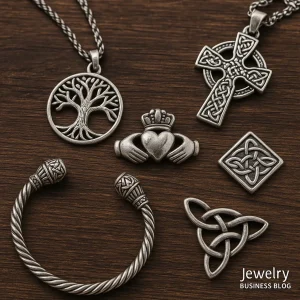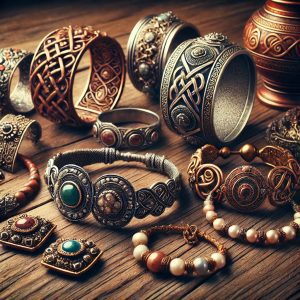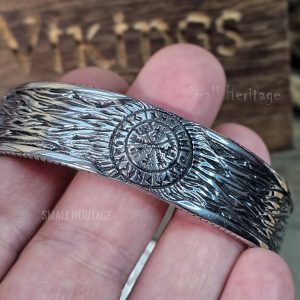When selling jewelry online, choosing the right platform is one of the most crucial steps in growing your business. Selling jewelry online offers incredible opportunities, but each platform comes with its own unique strengths, target audiences, and specific requirements, making it essential to align your choice with your business goals. If you’re new to the industry, understanding these differences is key to making the right decision. For those just beginning, check out our comprehensive guide on starting a jewelry business for essential tips and steps to set up your business on solid ground. In this post, we’ll explore some of the most popular platforms for selling jewelry online, including Etsy, eBay, Amazon, and others, to help you decide which one is the best fit for your business.
Top Selling Jewelry Platforms: Best Choices for Online Success
Choosing the right platform is vital when selling jewelry online. Each option offers different features, target audiences, and benefits tailored to your business goals
1. Etsy for Jewelry Sellers
Overview of Etsy for Jewelry Sales
Etsy is a popular marketplace known for handmade, vintage, and unique items. It’s a great place for independent jewelry designers who create their own products or sell vintage pieces. If your jewelry has a personal touch or a unique story, Etsy could be the perfect platform for you.
Key Features for Selling Jewelry on Etsy
- Listing Fees: Etsy charges $0.20 per item listed, plus a 5% transaction fee on the sale price (including shipping).
- Target Audience: Etsy attracts buyers looking for something special and one-of-a-kind. If you’re an artisan, crafter, or sell vintage jewelry, Etsy’s niche audience is ideal.
- Product Listings: You can upload up to 10 photos per listing, along with detailed descriptions, pricing, and shipping options.
- Customization: Etsy allows sellers to offer custom options, such as engraving or material choices, making it easier to cater to specific customer preferences.
Targeting Jewelry Buyers on Etsy
Etsy’s audience is highly engaged with products that are unique, personalized, or have a story behind them. This makes it ideal for sellers who create handmade or custom jewelry or offer vintage pieces.
Requirements for Jewelry Sellers on Etsy
- Handmade or Vintage: Items must be either handmade, vintage (at least 20 years old), or craft supplies.
- Seller Fees: Etsy charges a 3% + $0.25 payment processing fee in the U.S. (fees vary by country).
- Branding: While Etsy offers limited branding options, you can create a custom shop banner and logo to make your store stand out.
Tips for Success on Etsy
- Use High-Quality Photos: Since buyers can’t physically touch your jewelry, photos are crucial. Make sure to include multiple angles and close-ups.
- Optimize for Search: Use relevant keywords in your titles and descriptions to help your items appear in search results.
- Engage with Customers: Respond to customer inquiries quickly and provide excellent service to build a positive reputation.
2. Selling Jewelry on eBay
Overview of eBay Jewelry Marketplace
eBay is one of the world’s largest online marketplaces, where you can sell both new and pre-owned jewelry. It’s a versatile platform that allows you to choose between auction-style listings or fixed-price sales, giving you flexibility depending on your inventory and sales strategy.
Key Features for eBay Jewelry Sellers
- Listing Fees: You can list up to 250 items per month for free; additional listings cost $0.35 each. eBay also charges a final value fee, typically around 10% of the sale price.
- Target Audience: eBay’s broad audience includes buyers interested in deals, auctions, and unique finds. It’s a great place for selling everything from affordable fashion jewelry to high-end pieces.
- Product Listings: eBay allows up to 12 photos per listing and encourages detailed descriptions with specifics like metal type, gemstone, and condition.
- Auction vs. Buy It Now: Choose between auctioning your items or setting a fixed “Buy It Now” price.
Targeting Jewelry Buyers on eBay
eBay attracts a diverse range of buyers, from bargain hunters to collectors looking for unique pieces. It’s a great platform for selling both new and used jewelry, including items that might not fit the niche criteria of other platforms.
Requirements for Selling Jewelry on eBay
- Maintain Good Seller Ratings: You need to keep good ratings and comply with eBay’s policies, especially for higher-value items.
- Payment: eBay handles payments directly, deducting fees before transferring the balance to you.
Tips for Success on eBay
- Price Competitively: Check what similar items are selling for to price your jewelry competitively.
- Be Detailed: Include as much detail as possible in your descriptions to build trust, especially for pre-owned jewelry.
- Use Promotions: Take advantage of eBay’s promotional tools to increase visibility and sales.
3. Selling Jewelry Platforms: Amazon’s Jewelry Marketplace
Overview of Amazon for Jewelry Sales
Amazon offers a vast customer base and a dedicated section for fine jewelry. While it’s an excellent platform for reaching a large audience, selling on Amazon comes with stricter guidelines and intense competition, especially in the jewelry category.
Listing Fees: Amazon charges a referral fee (around 20% for jewelry) and a variable closing fee. The professional seller plan costs $39.99 per month.
Target Audience: Amazon caters to a broad audience, ranging from budget-conscious shoppers to those looking for luxury items. If you have the resources to meet Amazon’s strict requirements, it can be a highly profitable platform.
Product Listings: Amazon requires detailed product listings with high-quality images, precise descriptions, and specific attributes like material, size, and weight.
Brand Registry: Registering your brand with Amazon helps protect your intellectual property and gives you access to advanced marketing tools.
For a detailed overview of how to start selling on Amazon, including steps to set up your account and optimize your listings, visit the official Amazon Seller page here.
Targeting Jewelry Buyers on Amazon
Amazon’s vast customer base includes shoppers looking for everything from budget-friendly fashion jewelry to high-end, luxury pieces. The platform’s trust and convenience make it a powerful channel for established jewelry brands.
Requirements for Selling Jewelry on Amazon
- Approval Process: Selling fine jewelry on Amazon requires approval, with strict quality standards and product documentation.
- Fulfillment by Amazon (FBA): You can use FBA to store your inventory in Amazon’s warehouses, with Amazon handling shipping, returns, and customer service.
- Compliance: You must meet Amazon’s Jewelry Quality Assurance Standards and follow all relevant regulations.
Tips for Success on Amazon
- Build Your Brand: Use Amazon’s brand registry to protect your brand and gain access to marketing tools.
- Encourage Reviews: Positive customer reviews are crucial on Amazon. Encourage satisfied customers to leave feedback.
- Use FBA: Consider using FBA to make your products eligible for Amazon Prime, which can boost visibility and sales.
4. Comparing Etsy, eBay, and Amazon for Jewelry Sales
Choosing the best platform depends on what you’re selling and who you’re selling to:
- Etsy: Ideal for handmade, custom, or vintage jewelry, especially if you’re targeting a niche audience.
- eBay: Perfect for both new and pre-owned jewelry, with flexible options for auctions or fixed-price sales.
- Amazon: Best suited for sellers who can meet strict guidelines and want to reach a broad, potentially global audience.
5. Alternative Selling Jewelry Platforms to Explore
1stDibs: A Luxury Jewelry Marketplace
1stDibs is a luxury marketplace for high-end jewelry and designer items. It’s an exclusive, invitation-only platform, making it ideal for sellers of premium, one-of-a-kind pieces.
- Target Audience: Affluent buyers looking for luxury items.
- Requirements: Strict vetting process; sellers must apply and be approved.
Ruby Lane: Selling Vintage and Antique Jewelry
Ruby Lane is known for vintage and antique jewelry, art, and collectibles. If you specialize in historical pieces, Ruby Lane is a great fit.
- Target Audience: Collectors and buyers interested in vintage and antique jewelry.
- Requirements: There’s a monthly maintenance fee, plus listing and transaction fees.
Bonanza: An Alternative to eBay for Jewelry Sellers
Bonanza is similar to eBay but focuses more on a personalized shopping experience. It’s a good option for both new and pre-owned jewelry.
- Target Audience: General audience with an emphasis on user-friendly experiences.
- Requirements: Lower fees than eBay, with flexible listing options.
Conclusion: Choosing the Best Platform to Sell Jewelry Online
In conclusion, selecting the right platform for selling jewelry online can significantly impact your business success. Each platform offers unique advantages and challenges, so it’s important to consider your specific business needs, your target audience, and your long-term goals. Whether you’re an artisan on Etsy, a vintage seller on eBay, or aiming to scale up on Amazon, understanding the specifications, targeting options, and requirements of each platform will help you make the best choice for your jewelry business.
By choosing the right platform and tailoring your approach to meet its requirements, you can effectively reach your audience, build your brand, and grow your sales.





